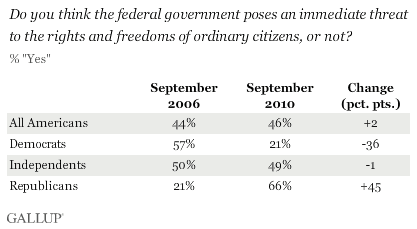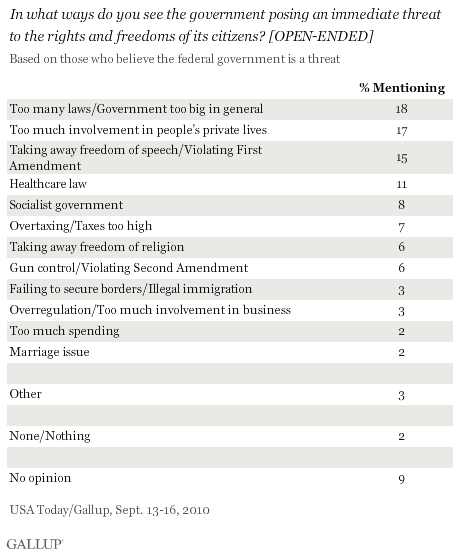PRINCETON, NJ -- Overall, 46% of Americans believe the federal government "poses an immediate threat to the rights and freedoms of ordinary citizens," little changed from the prior reading in 2006. However, during that time, Republicans' and Democrats' views of the government as a threat have shifted dramatically.

The results suggest that Americans' perceptions of the government as a threat may be less dependent on broader, philosophical views of government power, and instead have more to do with who is wielding that power. Throughout the Bush administration, Democrats were more likely than Republicans to perceive the government as a threat. Now that a Democratic president is in office, the reverse is true.
Since 2003, when the question was first asked, independents' views have been more consistent, although independents have been somewhat more likely to perceive the government as a threat since 2006 than they were before that year.

The increase in the percentage of independents believing the government is a threat has helped to push the overall percentage of Americans holding this view to new highs in 2006 and 2010.
Gallup this year for the first time asked Americans who believe the government is a threat to explain the ways in which they see this occurring. Many of the responses were fairly general in nature -- the government is too big, too involved in people's private lives, or is socialist. However, some mention very specific reasons, such as perceived violations of their First and Second Amendment rights, and the healthcare law.

The reasons people give for viewing the government as a threat would likely differ if the question were asked while a Republican was in the White House, given that relatively few Democrats currently view government as a threat and their ideas about the types of threats government could pose are likely not the same as Republicans'.
Implications
Americans who see the government as a threat today are very different politically from the people who did so four years ago. Gallup has previously documented similar shifts in the way partisans view national conditions when the party of the president changes. This phenomenon extends even to measures of Americans' own lives.
The partisan shift in views of government as a threat may explain why there hasn't been a large increase since 2006 in the overall percentage viewing the government as a threat, even as the federal government under both George W. Bush and Barack Obama has been more active in trying to solve the problems confronting the nation.While Republicans may see higher taxes or government involvement in healthcare as threatening to individual rights and freedoms, Democrats may not. On the other hand, Democrats may see involvement in wars or anti-terrorism activities as threatening, while Republicans may not. In other words, people's perceptions of the government as a threat may not be based as much on how much it is doing but rather on what it is doing.
Results for this USA Today/Gallup poll are based on telephone interviews conducted Sept. 13-16, 2010, with a random sample of 1,019 adults, aged 18 and older, living in the continental U.S., selected using random-digit-dial sampling.
For results based on the total sample of national adults, one can say with 95% confidence that the maximum margin of sampling error is ±4 percentage points.
Interviews are conducted with respondents on landline telephones (for respondents with a landline telephone) and cellular phones (for respondents who are cell phone-only). Each sample includes a minimum quota of 150 cell phone-only respondents and 850 landline respondents, with additional minimum quotas among landline respondents for gender within region. Landline respondents are chosen at random within each household on the basis of which member had the most recent birthday.
Samples are weighted by gender, age, race, education, region, and phone lines. Demographic weighting targets are based on the March 2009 Current Population Survey figures for the aged 18 and older non-institutionalized population living in continental U.S. telephone households. All reported margins of sampling error include the computed design effects for weighting and sample design.
In addition to sampling error, question wording and practical difficulties in conducting surveys can introduce error or bias into the findings of public opinion polls.
For more details on Gallup's polling methodology, visit www.gallup.com.
